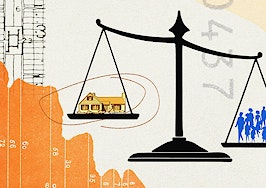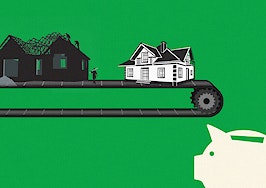This report is available exclusively to subscribers of Inman Intel, a data and research arm of Inman offering deep insights and market intelligence on the business of residential real estate and proptech. Subscribe today.
It was the mid-summer of 2022, and home prices were slipping downward for the first time since the beginning of the pandemic home-price boom.
Real estate had entered a new chapter. Industry leaders — already thoroughly embroiled in a steep downturn in transactions and revenue — were suddenly gripped by two questions: How far would prices fall, and how long would they take to hit bottom?
In hindsight, we now know that in most markets that price correction would feel like a moderate blip compared to the giant home-price boom that had occurred in the two years beforehand. The price downturn would only last about half a year, coinciding with the traditionally slower real estate seasons of fall and winter.
By the time the calendar turned the page to 2023, home values began to rebound. They’ve since regained all their losses nationwide as a shrunken pool of buyers has scrapped over an even more limited number of fresh home listings.
This leaves the market on the precipice of an uncertain moment heading into the fall of 2023. What will this cooler season hold for transactions and prices, the dual lifebloods of every business that depends on real estate commissions for revenue?
To help set the stage for this fall season, Intel examined housing market data from Zillow Research and reviewed projections from economists at housing giant Fannie Mae, data firm CoreLogic and Windermere Real Estate.
What Intel found is that a number of housing forecasters appear to expect an unusual degree of home-value appreciation for a season that typically features slower price growth. But even if this occurs, it would only partly offset the expected downturn in home transactions that occurs after the summer rush for houses comes to an end.
“Is it going to be easier this fall? I’m afraid it’s not,” said Matthew Gardner, Windermere’s chief economist, at the Inman Connect real estate conference in August. “And next year, will sales rise next year? Yes, they will, to about 4.8 million transactions — still below 5 million. And that would be the lowest figure we’ve seen since 2012.”
Fall may not be hot in terms of transaction revenue. But if this low-inventory environment continues to push up prices in a manner that’s uncharacteristic for the slower fall season, it could prevent real estate commissions from declining by as much as they otherwise might.
A more subdued season
In this era of wild swings in mortgage rates, the old seasonal expectations for home prices have been thrown out the window.
The chart below illustrates just how different each recent fall buying season has looked from near-term historical norms, which are represented by the dashed white line.

Chart by Daniel Houston
As we can see above, historically, price growth has been stagnant nationally from September through December. It dips ever so slightly in the slowest season in the late winter. And then, as buyers and sellers ramp up for real estate’s busy season, price growth takes off.
By the fall of 2020 and 2021 — represented by the blue lines above — ultra-cheap mortgage loans had contributed to a surge in buyer demand. But by the fall of 2022, mortgage rates were more than double what they had been. The housing market is still dealing with the fallout from that tectonic shift.
So for now, it seems that seasonal factors are once again making an imprint on home prices in a way that they often didn’t during the extreme housing environment of the early pandemic. The question is, which of the paths above will the market end up taking?
What’s propping up prices
If housing demand remains in a protracted downturn, with no signs of abating any time soon, then why are prices back on an upward trajectory?
It’s because, as quickly as buyers have backed out of the market, sellers — sitting on much more attractive mortgage rates on their current loans than they could lock in on the market today — have been fleeing faster.
This has resulted in a market that remains as unbalanced against buyers as it’s been throughout most of the pandemic.
One of the key metrics tracked by real estate professionals in every market in the country is “months of inventory,” which mainly reflects two things: The number of listings available on the market, and how quickly those listings are selling.
Taken as a whole, the amount of inventory available at the current sales pace paints a fairly telling picture of whether it is buyers or sellers who hold more sway in negotiations.
If a market has about six months’ worth of active inventory at a given time, it’s considered to have a balanced dynamic between buyers and sellers. If it has fewer than six months of inventory, it’s referred to as a seller’s market, where multiple buyers are often competing over a relatively small number of listings.
In the late summer and fall, inventory typically begins to recover as buyer activity wanes, resulting in more buyer-friendly conditions — and less upward pressure on prices.
But in recent years, the market hasn’t always followed that trend.

Chart by Daniel Houston
One of the major questions facing the market today is whether we’ll see a replenishment of inventory in the fall and winter, or whether the current environment that discourages homeowners from moving will continue to cut into new listings.
Resistant to change — so far
Only time will tell whether the fall of 2023 will experience a similar recovery in inventory that the market experienced at the same time last year. But one difference is apparent: Pending sales and new listings are in a very different place than they were a year ago.
Over the last 12 months, new listings fell off by 26 percent, according to data from Zillow. That drop in new inventory coming online greatly exceeded the 17 percent decline in pending sales over the same period.

Chart by Daniel Houston
At this time last year, when a seasonal inventory recovery was underway, the dynamic was reversed. New listings were down 6 percent year over year in July of 2022, while pending sales were down 14 percent. This allowed the market to replenish a bit with listings while taking upward pressure off prices.
This year, inventory may not see the same degree of recovery. If that’s the case, some of that upward pressure on home prices would return. And that’s what several housing forecasters expect to see this fall.
The bottom line
How does this all affect commissions?
If home prices continue to head upward, it could blunt the impact of a weak transaction environment, at least in the short run.
And indeed, after a disappointingly soft spring, the gap between this year’s estimated real estate commissions revenue and last year’s has begun to close in the late summer.

Chart by Daniel Houston
What’s clear is that — as happens every fall — commissions are beginning their usual downward trend that will continue through the winter.
Forecasters at Fannie Mae believe that those transactions could come in even weaker than on a seasonally adjusted basis, dropping from a seasonally adjusted annual rate of 5 million total sales in the second quarter of the year to something closer to a rate of 4.8 million in the back half of the year.
Still, Fannie Mae expects price growth to remain strong. The agency projects that annual price growth will rise from 3.4 percent in the second quarter to 3.5 percent in the third quarter, and then to 3.9 percent in the final three months of the year.

Table by Fannie Mae
Fannie Mae isn’t alone. Zillow’s own home value forecast is actually even more bullish and anticipates annual price growth rising to as high as 5.8 percent by December. Under their forecast, the rate of price growth would max out around 6.5 percent year-over-year in the early summer of 2024.
Actual and projected home-value change, year-over-year

Chart by Zillow Research
In a recent projection, data provider CoreLogic also said it expects home price appreciation to pick up steam in the remaining months of 2023, topping out around 7 percent year-over-year growth sometime in early 2024.
It’s an assumption driven by the factors above, but also bigger-picture macroeconomic trends, CoreLogic Chief Economist Selma Hepp said in the company’s report.
“While the continued imbalance between buyers and sellers continues to pressure home prices, June’s annual bump in price growth echoes economic resiliency, a thriving U.S. job market and strong consumer spending,” Hepp said.
Regardless of which projection ends up closest to the mark, most experts expect the upcoming fall season to be just the next chapter in a protracted recovery from this housing downturn.
It will likely take a while, Gardner said. Only when mortgage rates fall nearer to the rates that homeowners have on their loans will transactions pick up again, Gardner told the audience at Connect.
“It is going to take some time to get the market back to that sense of normalcy,” Gardner said. “It won’t happen this year. We will see more transactions next year, but not as [many] as you’d like to see.
“But it’s going to be OK. We will get there. I think the market going forward, there are more positives than there are negatives. But it’s just going to take some time.”













